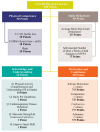Assessment of the Relationship between Body Weight Status and Physical Literacy in 8 to 12 Year Old Pakistani School Children: The PAK-IPPL Cross-Sectional Study
- PMID: 36832492
- PMCID: PMC9955071
- DOI: 10.3390/children10020363
Assessment of the Relationship between Body Weight Status and Physical Literacy in 8 to 12 Year Old Pakistani School Children: The PAK-IPPL Cross-Sectional Study
Abstract
(1) Background: Physical literacy (PL) is a multidimensional concept, since it fosters lifetime engagement in physical activities and reduces obesity; however, empirical evidence is lacking to support this association. This study first aimed to establish PL levels stratified by normal weight children and children with overweight and obesity. Furthermore, this study determined a correlation between PL domains and BMI by weight status among South Punjab school children. (2) Methods: This cross-sectional study involved 1360 (Boys: 675 and Girls: 685) children aged 8 to 12, and was conducted using CAPL-2. T-tests and chi-square were used to determine the difference between categorical variables, with MANOVA used to compare weight statuses. Spearman correlation was employed to determine the correlation between variables; p < 0.05 was considered significant. (3) Results: Normal weight children had significantly higher PL and domain scores, except for the knowledge domain. Most children with normal weights were at the achieving and excelling levels, while children with overweight and obesity were at the beginning and progressing levels. The correlation among PL domains in normal and overweight and obese children ranged from weak to strong (r = 0.001 to 0.737), and the knowledge domain was inversely correlated with the motivation domain (r = -0.023). PL and domain scores were inversely correlated to BMI, except for the knowledge domain. (4) Conclusions: Children with normal weight tend to have higher PL and domain scores, while those with overweight or obesity tend to have lower scores. There was a positive relationship between normal weight and higher PL and domain scores, and an inverse relationship was observed between BMI and higher PL scores.
Keywords: CAPL-2; childhood obesity; correlation analysis; daily behavior; physical competence; physical literacy among Pakistani children; school children.
Conflict of interest statement
The authors declare no conflict of interest.
Figures



References
-
- WHO . Noncommunicable Diseases: Childhood Overweight and Obesity. World Health Organization; Geneva, Switzerland: 2020.
-
- WHO . Report of the Commission on Ending Childhood Obesity: Implementation Plan: Executive Summary. World Health Organization; Geneva, Switzerland: 2017.
-
- WHO . Obesity: Preventing and Managing the Global Epidemic. World Health Organization; Geneva, Switzerland: 2000. - PubMed
Grants and funding
LinkOut - more resources
Full Text Sources
Research Materials

